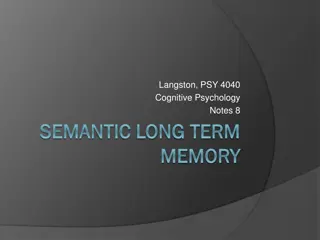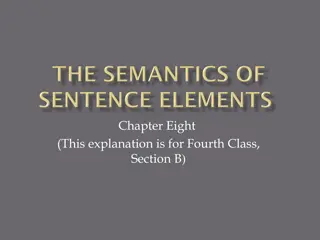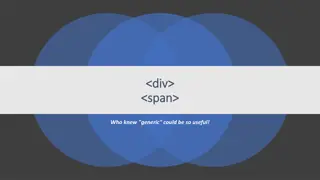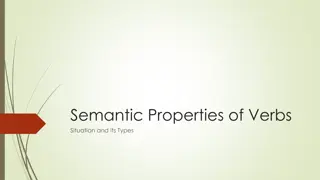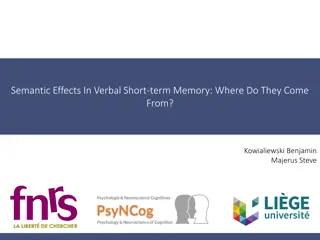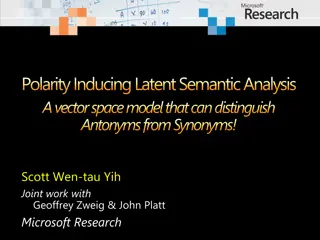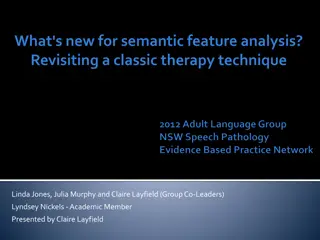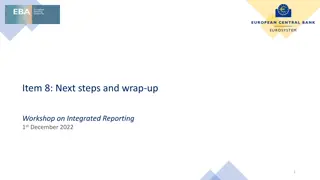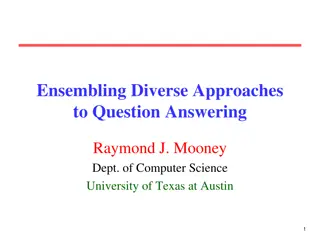Understanding Semantic Features in Language Study
Studying basic conceptual meaning is crucial in language analysis to explain the oddness in sentences like "The hamburger ate the boy." Semantic roles and thematic roles help identify the roles of entities in a sentence, such as agents and themes. By analyzing the components of conceptual meaning, we can better understand language structure and meaning.
Download Presentation

Please find below an Image/Link to download the presentation.
The content on the website is provided AS IS for your information and personal use only. It may not be sold, licensed, or shared on other websites without obtaining consent from the author. Download presentation by click this link. If you encounter any issues during the download, it is possible that the publisher has removed the file from their server.
E N D
Presentation Transcript
Semantic Features Componential analysis
One obvious way in which the study of basic conceptual meaning might be helpful in the study of language would be as a means of accounting for the oddness we experience when we read sentences such as the following: The hamburger ate the boy. The table listens to the radio. The horse is reading the newspaper
We should first note that the oddness of these sentences does not derive from their syntactic structure. According to the basic syntactic rules for forming English sentences (as presented in chapter 9), we have well- formed structures. NP V NP The hamburger ate the boy This sentence is syntactically good, but semantically odd. Since the sentence The boy ate the hamburger is perfectly acceptable, we may be able to identify the source of the problem. The components of the conceptual meaning of the noun hamburger must be significantly different from those of the noun boy, thereby preventing one, and not the other, from being used as the subject of the verb ate. The kind of noun that can be the subject of the verb ate must denote an entity that is capable of eating . The noun hamburger does not have this property and the noun boy does
table horse boy man girl woman animate + + + + + human + + + + female + + adult + + +
The------------- is reading the newspaper. N [+human]
Instead of thinking of words as containers of meaning, we can look at the roles they fulfill within the situation described by a sentence. If the situation is a simple event, as in The boy kicked the ball, then the verb describes an action (kick). The noun phrases in the sentence describe the roles of entities, such as people and things, involved in the action. We can identify a small number of semantic roles (also called thematic roles ) for these noun phrases.
Agents and themes are the most common semantic roles. Although agents are typically human (The boy), they can also be non-human entities that cause actions, as in noun phrases denoting a natural force (The wind), a machine (A car), or a creature (The dog), all of which affect the ball as theme
The boy kicked the ball. The wind blew the ball away. A car ran over the ball. The dog caught the ball
The theme is typically non-human, but can be human (the boy), as in The dog chased the boy. In fact, the same physical entity can appear in two different semantic roles in a sentence, as in The boy cut himself. Here The boy is agent and himself is theme
Instrument and experiencer If an agent uses another entity in order to perform an action, that other entity fills the role of instrument. In the sentences The boy cut the rope with an old razor and He drew the picture with a crayon, the noun phrases an old razor and a crayon are being used in the semantic role of instrument. When a noun phrase is used to designate an entity as the person who has a feeling, perception or state, it fills the semantic role of experiencer. If we see, know or enjoy something, we re not really performing an action (hence we are not agents).We are in the role of experiencer. In the sentence The boy feels sad, the experiencer (The boy) is the only semantic role.
Location, source and goal A number of other semantic roles designate where an entity is in the description of an event. Where an entity is (on the table, in the room) fills the role of location. Where the entity moves from is the source (from Chicago) and where it moves to is the goal (to New Orleans), as in We drove from Chicago to New Orleans. When we talk about transferring money from savings to checking, the source is savings and the goal is checking



